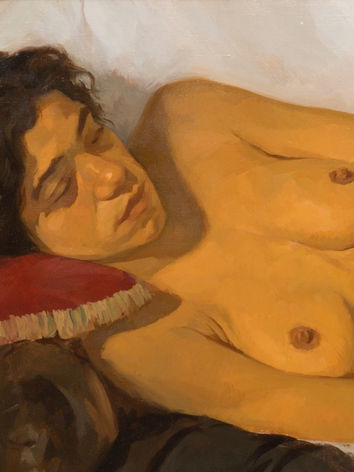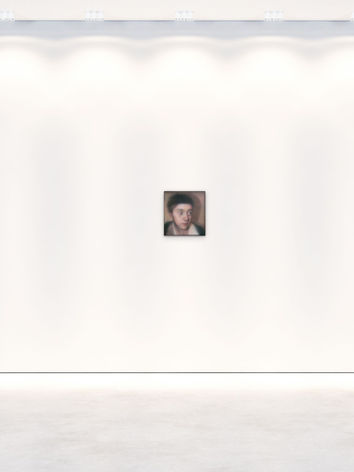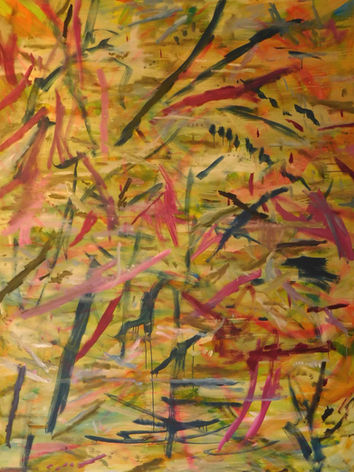From Nothing to flesh AND FROM FLESH TO NOTHING
"Balzac sensed for a long time that in painting something so tremendous can suddenly appear that nobody can handle it."
Rainer Maria Rilke in a letter to his wife, Clara Rilke, 1907.
There is no deeper mystery than that of the generation of life out of nothing. None resembles the inexplicable phenomenon of incarnation, except possibly, the artistic act, as the creation of something –at once material, intellectual and spiritual– where there wasn’t before. By envisioning an equivalence between art and life, many philosophers, writers and mystics have intuited that there is also one between the artist and God. In the preface to one of the most fundamental texts in the history of Western art, "The Lives of the Most Excellent Italian Architects, Painters, and Sculptors" (1550), Giorgio Vasari (1511-1574) wrote that God was the first artist. When referring to the life of Michelangelo, Vasari insisted on the comparison between creation and art by saying that, when observing "The Creation of Adam", one does not seem to be contemplating the work of a brush but creation itself.
In his extraordinarily visionary 1831 short novel "The Unknown Masterpiece”, Honoré de Balzac (1799-1850) introduces three painters of different ages and in different cycles of artistic maturity: the young and inexperienced Poussin, the respected and established painter Porbus and the old master Frenhofer. Balzac raises, among other questions, the dissolution of the limits between painting and being, the fascinating metamorphosis of the pictorial object into what it represents and the role that the artist plays in that transformation, fueled by the erotic-loving impulse.
Like the sculptor Pygmalion –who was seduced by the beauty of his cold marble effigy until it was transformed into a flesh and blood woman– the old Frenhofer has fallen in love with his own creation and jealously hides it in the secrecy of his workshop, since displaying it in front of other people's eyes would be tantamount to corrupting it; to the old painter, painting –his painting– has turned into flesh and to look at it is to possess it. This obsession with the artwork-woman leads him towards the end of the story to destroy it and to destroy himself. Thus, Balzac suggests a variation of the Faustian myth: the search for the absolute in exchange for death, the creative and destructive potential –the tension of Eros and Thanatos– that throb within the artist.
In contrast to the humanization of the painting, Balzac also proposes the objectification of the person –more specifically, of a woman– in the name of art: the young Poussin surrenders his beloved Gillette and offers her as a model to Frenhofer in exchange for witnessing his great hidden masterpiece. Once again, there is a correspondence between gaze and sexual possession.
"The Unknown Masterpiece" was the trigger and curatorial pivot of this virtual exhibition entitled "This Room No Longer Has Walls", made up of seven painters from different geographical origins and generations: Peter Clossick (London, 1948), Juan Carlos del Valle (Mexico City, 1975), Antonio Gritón (Mexico City, 1953), Sherry Kerlin (New York, 1944), Roberto Rébora (Guadalajara, 1963), Germán Venegas (Puebla, 1959) and Neale Worley (Buckinghamshire, 1962). The exhibition pays tribute to painting, the painter and plastic creation driven by love. Each of the participants in this pictorial encounter explores notions related to the limits of representation, the skin and the pictorial flesh, the conflicting polarities of eroticism and death, and the tension between the painted subject-object and being.
Balzac's novel, read and reread, interpreted and reinterpreted countless times from 1831 to the present, fascinated paradigmatic modern artists such as Cézanne, Matisse or Picasso. The latter, in addition to illustrating Balzac's history with a series of etchings, lived between 1937 and 1955 at number 7 Rue des Grand-Augustins in Paris, the historic house where the first chapter of the novel is set.
Unlike that mythical Parisian studio, "This Room No Longer Has Walls" proposes a fluid room, without temporal or spatial walls, alluding to the possibility of visiting the exhibition in a virtual room that lacks physical barriers and whose starting point as well as its point of arrival is painting itself: present, past and future.
VIRTUAL TOUR
WORKS
JUAN CARLOS DEL VALLE
Dough, 2021
Oil on canvas
25 x 20 cm
PETER CLOSSICK
Mirror Self, 2016
Oil on wood on panel
62 x 62 cm
ROBERTO RÉBORA
Nariz de Laris, 2021
Graphite and tempera on paper
30 x 30 cm
PETER CLOSSICK
Mirror, Mirror, 2016
Oil on wood on panel
71 x 51 cm
*Prize-winning painting in the New English Art Club Annual, 2016.
NEALE WORLEY
Studio Model
Oil on canvas
91.4 x 81.3 cm
NEALE WORLEY
Tania's Boots
Oil on canvas
76.2 x 91.4 cm
SHERRY KERLIN
Bee Seduced by Painted Flowers on a Vase, 2021
Oil and acrylic on canvas
55.9 x 40.6 cm
SHERRY KERLIN
Picasso Stalking Marie Therese through the Streets of Paris, 2021
Oil and acrylic on canvas
45.7 x 40.6 cm
GERMÁN VENEGAS
Cargando con su muerto I, 2006
Oil on linen
180 x 120 cm
GERMÁN VENEGAS
Cargando con su muerto II, 2006
Oil on linen
180 x 120 cm
ROBERTO RÉBORA
Autocastración, 2018
Oil on canvas
90 x 100 cm
JUAN CARLOS DEL VALLE
Erased, 2004
Oil on canvas
23 x 18 cm
ANTONIO GRITÓN
Mujer desnuda mirando al oriente, 2018
Oil on canvas
200 x 150 cm
ANTONIO GRITÓN
Mujer desnuda esperando los años 1, 2020
Oil on canvas
180 x 120 cm




















































































